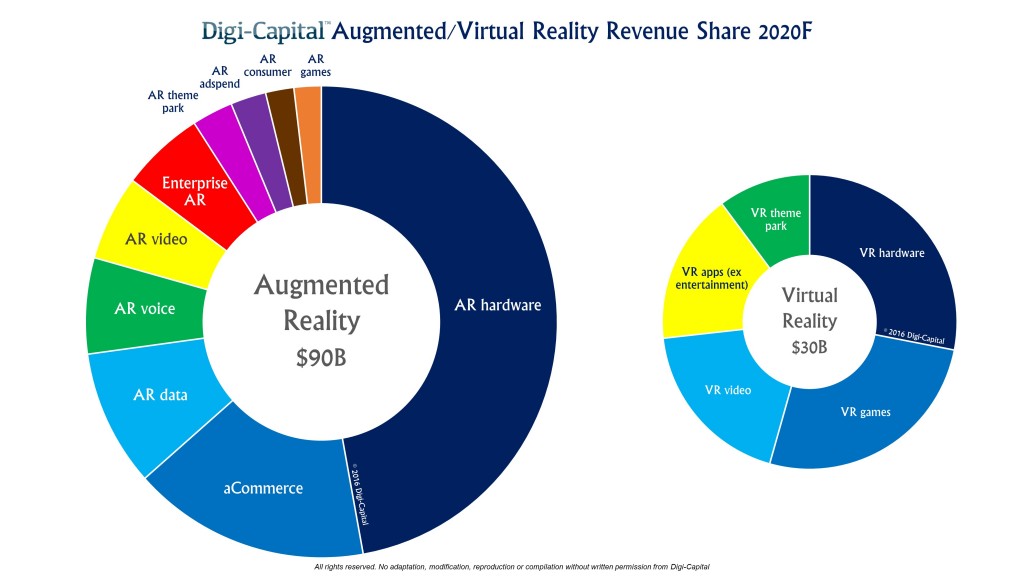Augmented/Virtual Reality revenue forecast revised to hit $120 billion by 2020

What is Augmented Reality?
Augmented reality is a combination of digital information that is connected to the users in real time. AR collects the information of the environment and overlays new information on top of it. It helps the user to place life-size 3D models in the environment of their own choice. AR is becoming more popular in the gaming industries, to ensure the user gets the immersive experiences that utilize their actual surroundings. Pokemon go is one such example.
Click here to read more on AR/VR
There is a lot of competition among social media games and applications. Each one of them is trying hard to improve  engagement rate through increased user interaction with advanced technologies. In this situation, leveraging the potential of Augmented Reality comes as a rescue.
engagement rate through increased user interaction with advanced technologies. In this situation, leveraging the potential of Augmented Reality comes as a rescue.
Snapchat is the clear winner in the race of using AR for social media apps. This is the sure shot sign of increased use of this technology in social networking platforms in the near future.
Facebook: Facebook has designed an AR glasses so that user can experience the AR world right from their pockets.
The most successful application (mobile game) that has made a huge success in AR is “Pokemon GO”, the game spread so widely that it made a mark in the world of augmented reality.
 AR Kit of iOS 11 is the new entry of Apple into the AR segment. WWDC 2017 observed some major announcements done by Apple. One of them was the introduction of AR Kit. This tech giant sees the bright future of AR in enhancing users’ experience. It brings forth a new framework called AR Kit for developers to experiment this technology to its fullest.
AR Kit of iOS 11 is the new entry of Apple into the AR segment. WWDC 2017 observed some major announcements done by Apple. One of them was the introduction of AR Kit. This tech giant sees the bright future of AR in enhancing users’ experience. It brings forth a new framework called AR Kit for developers to experiment this technology to its fullest.
Apple has opened up ways for developers to build apps that go beyond the restricted screen size of the device. It is possible for them to craft immersive AR experience for users that provides perfect blending of digital objects with the real world.
Augmented reality social media and messenger apps have proven results of attracting users with its special effects. This technology has brought a new revolution among mobile phones users. Technology leaders are now dreaming of living in a world that is at the intersection of their imagination and real scenario. Introduction of AR in social media app that gives users just what they expect could be a grand success.

Virtual Reality
Virtual reality is a technology where an artificial environment is created through software and is presented to the users in such a way that the user tends to create a live experience. It is experienced with the help of VR Headsets. Everything that we know about our reality comes by way of our senses into VR.
Virtual Reality (VR) is one of the burning topics in tech right now, with buzz about its potential stretching from film, TV & games, to healthcare, retail and more. But it hasn’t seen nearly the same amount of attention in the education space.
Virtual reality is a versatile technology that has a broad range of applications, education being one of them. Teaching and learning have gone beyond the conventional norms of reading from a book and understanding.
The traditional learning methods need to be coupled with new advanced learning resources with the development of technology. This helps the students to visualize and understand concepts at a much extensive level.
There are different types of virtual reality systems but they all share the same characteristics such as the ability to allow the person to view three-dimensional images. These images appear life-sized to the user using it.
VR is getting a lot of attention from many different professions. Gaming is on top of it. Marketers are trying to get their heads around it. And visual storytellers are about as excited by the tech as they’ve ever been about any single technology in a long time.

Facts & Figures on AR/VR


“The Worldwide Semiannual Augmented and Virtual Reality Spending Guide examines the AR/VR opportunity and provides insights into this rapidly growing market and how the market will develop over the next five years. Revenue data is available for eight regions, 12 industries, 26 use cases, and eleven technology categories. Unlike any other research in the industry, the comprehensive spending guide was created to help IT decision makers to clearly understand the industry-specific scope and direction of AR/VR expenditures today and in the future.”
We’ll keep updating you AR/VR. Subscribe to get instant notifications.






